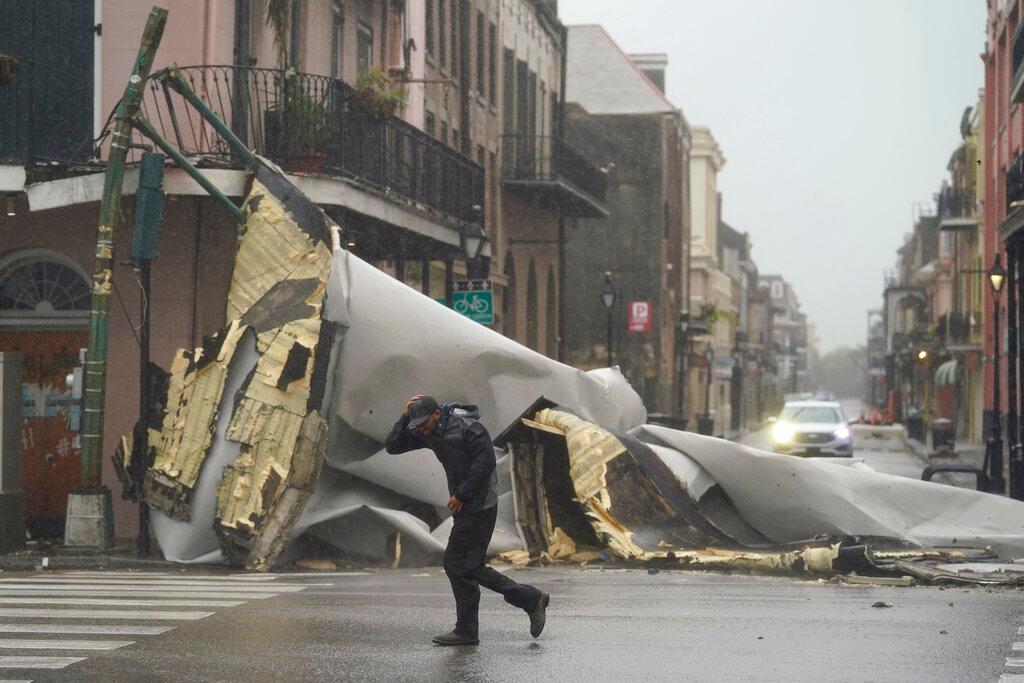Hurricane pummels US state, knocks out power for entire city
As of 9pm in Louisiana, Ida was packing maximum sustained winds of 175km per hour.
Just In
“Life-threatening” Hurricane Ida battered the southern US state of Louisiana and plunged New Orleans into darkness Sunday, 16 years to the day after Hurricane Katrina devastated the city.
Ida slammed into the Louisiana coast as a Category 4 storm and was downgraded to a Category 3 by evening – the same strength Katrina was when it came ashore in 2005.
As of 9pm, Ida was packing maximum sustained winds of 175km per hour, and the powerful storm knocked out power for all of New Orleans.
“@EntergyNOLA has confirmed that New Orleans has no power,” tweeted NOLA Ready, the city’s emergency preparedness programme, referring to the area’s electricity provider.
“The only power in the city is coming from generators.”
Ahead of Ida’s arrival, showers and strong wind swept New Orleans’ deserted streets throughout the morning, buffeting boarded-up windows at businesses and homes surrounded by sandbags.
Ida was 40 miles per hour slower than when it made landfall at Port Fourchon, Louisiana, approximately 100 miles south of New Orleans, but the National Hurricane Center said it remained a dangerous Category 3 storm.
The NHC also warned that the storm surge would create a “life-threatening situation” and urged residents in affected areas to “take all necessary actions to protect life and property.”
President Joe Biden had also described Ida as “a life-threatening storm” that “continues to rage and ravage everything it comes in contact with.”
Louisiana Governor John Bel Edwards said Ida could be the most powerful storm to hit the state since 1850.
“There is no doubt that the coming days and weeks are going to be extremely difficult,” he said at a briefing Sunday, adding that some people might have to shelter in place for up to 72 hours.
“Find the safest place in your house and stay there until the storm passes,” he tweeted earlier.
Storm surges flooded the town of Grand Isle, on a barrier island south of New Orleans, and low-lying highways in the area were covered in water.
‘Not sure if I’m prepared’
Most residents had heeded warnings of catastrophic damage and authorities’ instructions to flee.
Roads leading out of New Orleans had bumper-to-bumper traffic in the days preceding Ida’s arrival.
In one neighbourhood in eastern New Orleans, a few residents were completing preparations just hours before landfall.
“I’m not sure if I’m prepared,” said Charles Fields, who was bringing his garden furniture indoors, “but we just have to ride it.”
“We’ll see how it holds up,” added the 60-year-old, who in 2005 saw Hurricane Katrina flood his house with 3.3m of water.
In St Bernard Parish, a large ferry boat broke free of its moorings and was being blown up the Mississippi River, according to local TV channel WWL, which posted a video of the boat.
‘Very serious test’
Governor Edwards warned on Sunday that Ida would be “a very serious test for our levee systems”, an extensive network of pumps, gates and earthen and concrete berms that was expanded after Katrina.
He told CNN that hundreds of thousands of residents were believed to have evacuated.
The storm “presents some very challenging difficulties for us, with the hospitals being so full of Covid patients,” he said.
With a low rate of vaccination, Louisiana is among the states hit hardest by the pandemic, severely stressing hospitals.
Hospitalisations, at 2,700 on Saturday, are near their pandemic high.
The memory of Katrina, which made landfall on Aug 29, 2005, is still fresh in Louisiana, where it caused some 1,800 deaths and billions of dollars in damage.
“It’s very painful to think about another powerful storm like Hurricane Ida making landfall on that anniversary,” Edwards had previously said.
Rainfall of 10 to 18 inches (25 to 46cm) is expected in parts of southern Louisiana through Monday, with up to 24 inches in some areas.
The storm is expected to continue weakening as it moves over land, with a predicted track taking it north over the central US before veering eastward, reaching the mid-Atlantic region by Wednesday.
Ida and the coronavirus
The White House said Sunday that federal agencies had deployed more than 2,000 emergency workers to the region – including 13 urban search-and-rescue teams – along with food and water supplies and electric generators.
Local authorities, the Red Cross and other organizations have prepared dozens of shelters with room for at least 16,000 people, the White House added.
Plans to cope with the hurricane – and set up shelters – have been complicated by Covid-19.
Biden on Saturday urged anyone in community shelters to wear masks and maintain distance.
Scientists have warned of a rise in cyclone activity as the ocean surface warms due to climate change, posing an increasing threat to the world’s coastal communities.
Subscribe to our newsletter
To be updated with all the latest news and analyses daily.
Most Read
No articles found.
